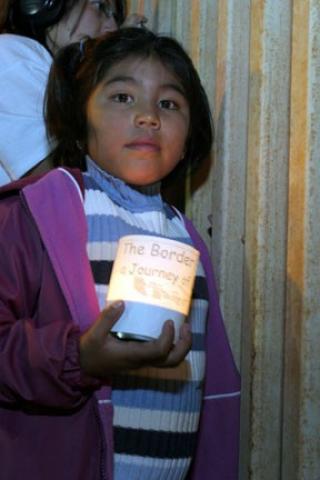
The article below is an excerpt from this longer piece written by Gabriela Romeri (writer/editor with Revista Maryknoll), Chelsey Clammer and Rae Bryant, and published originally on The Doctor T. J. Eckleburg Review website.
This article also was reprinted in the September-October 2013 issue of NewsNotes.
Each year thousands of children try to cross the U.S.-Mexico border. Most travel from Central America. On this journey — one that can be over 2,000 miles, the equivalent of walking from New York to Florida twice — the children must sneak past Border Patrol and guns. They must survive dehydration and starvation. They encounter gang violence and “coyotes,” who often abuse and extort them.There is an option to the long walk. La Bestia is what the immigrants call the train that runs through Mexico. Riding La Bestia is risky, however, as the poor must sit on top, vulnerable to the train’s violent shaking sometimes resulting in broken limbs and other injuries. Gangs patrol La Bestia, demanding $100 U.S. dollars per station. To refuse means being shot or stabbed and thrown off the train. La Bestia. The beast.
The children lucky enough to survive the walk or La Bestia will often end up in detention centers. Norma Lujan, an El Paso resident, works as a detention center volunteer. She reports, “They found a boy of 12 crossing the desert carrying his sister on his back, his nine-year-old sister was paraplegic, that’s how they found them… last night they found three little brothers trying to cross.” She is jubilant when the children survive.
Lujan is the mother of three girls. In 2008, when Obama took office, she started visiting the detention centers for children caught crossing the border. “There were 70 kids and two children detention centers here in El Paso.” Five years later, the child detention centers are at collective capacity of 250 children. They are building a fifth child detention center in El Paso, and Lujan says. “I’m going to have to recruit more parents.”
Through her church, St. Pius X Parish in El Paso, Lujan recognized that children were disappearing along the border. To date, she has recruited sixty parent volunteers, and she continues to recruit more. Their jobs are to comfort the children with visits and stories, songs, shared meals, the occasional hug, against policy, but impossible to deny. Many of the older girls arrive pregnant. This past summer, Lujan and her church held eleven baby showers. They have seen newborns taken from their mothers, nursing mothers deported, children entered into the U. S. foster care system. A lucky few, the “legals,” are reunited with their families.
[Learn more about an opportunity to contribute to Norma Lujan's project here: Help Immigrant Children in Detention Centers.]
In 2012, the number of Unaccompanied Alien Children (UAC) being detained by the U.S. government more than doubled — from 6,000 to more than 14,000 child detainees. This year, according to the Refugee Council: “It is expected that roughly 23,500 UAC will arrive by the end of this fiscal year 2013.” This is low compared to the 100,000 children that Border Patrol claims to prevent from crossing every year. The majority have traveled not from Mexico but from El Salvador, Guatemala, Honduras. The Women’s Refugee Commission reports that “desperate conditions” are part of “trends in Central America, including rising crime, systemic state corruption and entrenched economic inequality.” In Honduras alone, 920 children were murdered between January and March of 2012.
The detention centers offer housing. Some have outdoor, fenced-in playgrounds. Some do not. During the day, some children are taken by white vans to schools. Others are taught on site for two to three months while immigration judges decide their fates. This system, based in part on a family reunification policy, is more often concerned with borders than family.
There is one systemic grace. Inside the detention centers the children do not yet fear Immigration and Customs Enforcement (ICE) like so many immigrants attending U.S. public schools, where ICE is an unrelenting threat. At any time, these children and their families can be taken and separated. In just one year, according to the U.S. Dept. of Health and Human Services (DHS) there were 204,810 parents of U.S.-citizen children deported. Last year the number of kids detained more than doubled. To handle the rise in numbers, the centers converted gym floors into barracks with cots in order to house them. This year, the expected number is 23,500. ...
Read the rest of the article at The Doctor T.J. Eckleburg Review website.
Photo by Rick Reinhard.
